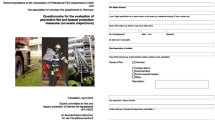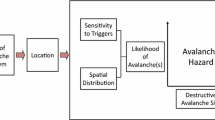Abstract
Avalanche hazard and risk mapping is of utmost importance in mountain areas in Europe and elsewhere. Advanced methods have been developed to describe several aspects of avalanche hazard assessment, such as the dynamics of snow avalanches or the intensity of snowfall to assume as a reference meteorological forcing. However, relatively little research has been conducted on the identification of potential avalanche release areas. In this paper, we present a probabilistic assessment of potential avalanche release areas in the Italian Autonomous Province of Bolzano, eastern Alps, using the Weights of Evidence and Logistic Regression methods with commonly available GIS datasets. We show that a data-driven statistical model performs better than simple, although widely adopted, screening criteria that were proposed in the past, although the complexity of observed release areas is only partly captured by the model. In the best case, the model enables predicting about 70 % of avalanches in the 20 % of area classified at highest hazard. Based on our results, we suggest that probabilistic identification of potential release areas could provide a useful aid in the screening of sites for subsequent, more detailed hazard assessment.






Similar content being viewed by others
References
Agterberg FP (1989) LOGDIA–FORTRAN 77 program for logistic regression with diagnostics. Comput Geosci 15(4):599–614
Barbolini M, Gruber U, Keylock CJ, Naaim M, Savi F (2000) Application of statistical and hydraulic-continuum dense-snow avalanche models to five real european sites. Cold Reg Sci Technol 31(2):133–149
Barbolini M, Natale L, Tecilla G, Cordola M (2001) Linee guida metodologiche per la perimetrazione delle aree esposte al pericolo di valanghe. AINEVA: http://www.aineva.it/pubblica/Quaderno_Finale.pdf. Last accessed 12 June 2010
Barbolini M, Natale L, Savi F (2002) Effects of release conditions uncertainty on avalanche hazard mapping. Nat Hazards 25(3):225–244
Barbolini M, Pagliardi M, Ferro F, Corradeghini P (2011) Avalanche hazard mapping over large undocumented areas. Nat Hazards 56(2):451–464
Barpi F (2004) Fuzzy modelling of powder snow avalanches. Cold Reg Sci Technol 40(3):213–227
Beven KJ, Kirkby MJ (1979) A physically based, variable contributing area model of basin hydrology/un modèle à base physique de zone d’appel variable de l’hydrologie du bassin versant. Bull Int As Sci Hydrol 24(1):43–69
Bocchiola D, Medagliani M, Rosso R (2006) Regional snow depth frequency curves for avalanche hazard mapping in central italian alps. Cold Reg Sci Technol 46(3):204–221
Bonham Carter G (1994) GIS for geoscientists. Pergamon, New York
Bonham Carter G, Agterberg FP, Wright DF (1989) Weights of evidence modeling: a new approach to mineral potential mapping. In: Bonham Carter G, Agterberg FP (eds) Statistical applications in the earth sciences, paper 89–9. Geological Survey of Canada, Ottawa, pp 171–183
Chung C-JF, Fabbri AG (1993) The representation of geoscience information for data integration. Nat Resourc Res 2(2):122–139
Chung CF, Fabbri AG (1999) Probabilistic prediction models for landslide hazard mapping. Photogramm Eng Remote Sens 65(12):1389–1399
Chung C-JF, Fabbri AG (2003) Validation of spatial prediction models for landslide hazard mapping. Nat Hazards 30(3):451–472
Dahal RK, Hasegawa S, Nonomura A, Yamanaka M, Dhakal S, Paudyal P (2008) Predictive modelling of rainfall-induced landslide hazard in the lesser Himalaya of Nepal based on weights-of-evidence. Geomorphology 102(3–4):496–510
Davis RE, Elder K, Howlett D, Bouzaglou E (1999) Relating storm and weather factors to dry slab avalanche activity at Alta, Utah, and Mammoth mountain, California, using classification and regression trees. Cold Reg Sci Technol 30(1–3):79–89
Delparte D, Jamieson B, Waters N (2008) Statistical runout modeling of snow avalanches using GIS in glacier national park. Canada. Cold Reg Sci Technol 54(3):183–192
Eckert N, Parent E, Bélanger L, Garcia S (2007a) Hierarchical bayesian modelling for spatial analysis of the number of avalanche occurrences at the scale of the township. Cold Reg Sci Technol 50(1–3):97–112
Eckert N, Parent E, Richard D (2007b) Revisiting statistical “topographical methods for avalanche predetermination: Bayesian modelling for runout distance predictive distribution. Cold Reg Sci Technol 49(1):88–107
EEA European Environmental Agency (2010) Mapping the impacts of natural hazards and technological accidents in Europe. Technical report No 13/2010, 149 pp
Ghinoi A (2008) Una nuova metodologia per la valutazione della suscettibilità valanghiva: come migliorare la carta di localizzazione Probabile delle valanghe (C.L.P.V.) utilizzando informazioni contenute nel catasto valanghe/A new methodology to evaluate land susceptibility to snow avalanches: how to improve the Location Map of Probable Snow Avalanches (L.M. P.S.A.) from the Snow Avalanches Inventory Data. Mem. Descr. Carta Geol. d’It., LXXVIII, pp. 93-104. http://www.isprambiente.gov.it/files/pubblicazioni/periodicitecnici/memorie/memorielxxviii/memdes-78-ghinoi.pdf/view. Accessed 5 Sep 2012
Ghinoi A, Chung C-J (2005) STARTER: a statistical GIS-based model for the prediction of snow avalanche susceptibility using terrain features” application to Alta val Badia, Italian dolomites. Geomorphology 66(1–4):305–325
Gruber U, Bartelt P (2007) Snow avalanche hazard modelling of large areas using shallow water numerical methods and GIS. Environ Model Softw 22(10):1472–1481
Hebertson EG, Jenkins MJ (2003) Historic climate factors associated with major avalanche years on the Wasatch plateau, Utah. Cold Reg Sci Technol 37(3):315–332
Hendrikx J, Owens I, Carran W, Carran A (2005) Avalanche activity in an extreme maritime climate: the application of classification trees for forecasting. Cold Reg Sci Technol 43(1–2):104–116
Hervas J (ed) (2003) Recommendations to deal with snow avalanches in Europe. EC-JRC Publication EUR 20839 EN. Office for Official Publications of the European Union, Luxembourg
Jomelli V, Delval C, Grancher D, Escande S, Brunstein D, Hetu B, Filion L, Pech P (2007) Probabilistic analysis of recent snow avalanche activity and weather in the French alps. Cold Reg Sci Technol 47(1–2):180–192
Keylock CJ (2005) An alternative form for the statistical distribution of extreme avalanche runout distances. Cold Reg Sci Technol 42(3):185–193
Maggioni M, Gruber U (2003) The influence of topographic parameters on avalanche release dimension and frequency. Cold Reg Sci Technol 37(3):407–419
McCammon I, Hägeli P (2007) An evaluation of rule-based decision tools for travel in avalanche terrain. Cold Reg Sci Technol 47(1–2):193–206
McClung D, Schaerer P, Schaerer PA (2006) The Avalanche handbook, 3rd edn. The Mountaineers Books, Seattle
Mears AI (1992) Snow-Avalanche hazard analysis for land-use planning and engineering. Bulletin 49, Colorado Geological Survey, Denver
Mölg N, Rastner P, Irsara L, Notarnicola C, Steurer C, Zebisch M (2010) Multi-temporal MODIS snow cover monitoring over the alpine regions for civil protection applications. In: 30th EARSel symposium, 31st May–3rd June, 2010, Paris, France
Neuhäuser B, Terhorst B (2007) Landslide susceptibility assessment using weights-of-evidence applied to a study area at the jurassic escarpment (SW-germany). Geomorphology 86(1–2):12–24
Oh H-J, Lee S (2010) Assessment of ground subsidence using GIS and the weights-of-evidence model. Eng Geol 115(1–2):36–48
Pistocchi A, Luzi L, Napolitano P (2002) The use of predictive modeling techniques for optimal exploitation of spatial databases: a case study in landslide hazard mapping with expert system-like methods. Environ Geol 41(7):765–775
Porwal A, González-Álvarez I, Markwitz V, McCuaig TC, Mamuse A (2010) Weights-of-evidence and logistic regression modeling of magmatic nickel sulfide prospectivity in the Yilgarn Craton, Western Australia. Ore Geol Rev 38(3):184–196
Regmi NR, Giardino JR, Vitek JD (2010) Modeling susceptibility to landslides using the weight of evidence approach: Western Colorado, USA. Geomorphology 115(1–2):172–187
Sawatzky DL, Raines GL, Bonham-Carter GF, Looney CG (2009) Spatial Data Modeller (SDM): ArcMAP 9.3 geoprocessing tools for spatial data modelling using weights of evidence, logistic regression, fuzzy logic and neural networks. http://arcscripts.esri.com/details.asp?dbid=15341. Accessed 10 March 2010
Schmidt-Thomé P (ed) (2006) The spatial effects and management of natural and technological hazards in Europe. ESPON 1.3.1 Report: http://www.preventionweb.net/files/3621_Finalreport.pdf; Accessed 12 June 2010
Schweizer J, Mitterer C, Stoffel L (2009) On forecasting large and infrequent snow avalanches. Cold Reg Sci Technol 59(2–3):234–241
Straub D, Grêt-Regamey A (2006) A bayesian probabilistic framework for avalanche modelling based on observations. Cold Reg Sci Technol 46(3):192–203
Acknowledgments
The research was partly funded within the Interreg IVb Project CLISP (www.clisp.eu). Geographical data, and particularly the CLPV avalanche register data, were provided by the Avalanche service of the Civil Protection Department of the Province of Bolzano. S. Kass, M. Zebisch and S. Schneiderbauer of the EURAC Institute for Applied Remote Sensing are gratefully acknowledged for technical help and discussion. S. Lermer helped performing some preliminary calculations during his internship at EURAC under the supervision of A. Pistocchi; results obtained in that context inspired parts of the present paper and will be a subject of a dedicated, upcoming contribution. Avalanche data were provided by the Civil Protection Service of the Autonomous Province of Bolzano—Alto Adige (Italy).
Author information
Authors and Affiliations
Corresponding author
Rights and permissions
About this article
Cite this article
Pistocchi, A., Notarnicola, C. Data-driven mapping of avalanche release areas: a case study in South Tyrol, Italy. Nat Hazards 65, 1313–1330 (2013). https://doi.org/10.1007/s11069-012-0410-3
Received:
Accepted:
Published:
Issue Date:
DOI: https://doi.org/10.1007/s11069-012-0410-3




